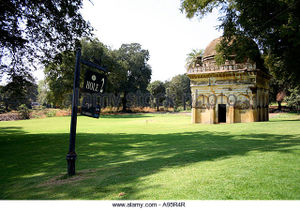Landscape Democracy 2015 Working Group B - Case Study 4: Difference between revisions
No edit summary |
No edit summary |
||
| Line 23: | Line 23: | ||
|lat=22°17'53.2 | |lat=22°17'53.2 | ||
|lng= 73°11'21.1 | |lng= 73°11'21.1 | ||
|zoom= | |zoom=20 | ||
|centermarker=yes | |centermarker=yes | ||
|maptypecontrol=yes | |maptypecontrol=yes | ||
Revision as of 22:18, 24 December 2015
---> back to group page working group B
Please add the title of your case study here, adjust the map coordinates (lat + lng) and replace the moa image with a characteristic image of your site
| Place name | NAVALAKHI COMPOUND | |
| Location | VADODARA | |
| Country | India | |
| Author(s) | Siddharth Trivedi | |

| ||
|
| ||
Rationale: Why have you chosen this case for the landscape and democracy seminar?
- The central location of the site and given resources (natural+cultural) are the main drivers for selecting this site. Also presently the site is not being used. Its amalgamation into the city fabric would have a very large impact on the future of the city. so it is important that people are made aware of the potentials and possibilities of this area. Already the local council has made some bad decisions about it in the recent past and have kind of led to deterioration in the quality of lifestyle around these places.
Representation of your observations
- you are basically free to use one or a mix of different presentation techniques
- possibilities are: analytical drawings, graphical representations, collages, video clips, comic/graphic novel, written essay/visual essay
- please add any visual material to the gallery, videos can be placed below, you may add text as you like
- Design Synthesis Drawings
- Yourfilename4.jpg
case representation
Reflection
What are the major challenges for changing the situation?
- The most important challenge is perhaps to get a diverse section of stakeholders cumulatively interested in this project. This city (like almost any other Indian city) has a lot of social and cultural baggage of intolerance.
- There is sometimes a very unfounded stubbornness displayed by the city council towards such public-participation models. If somehow the municipalties are to get involved this will lends a more authentic and widespread appeal for the people to actively participate.
- Making ecology/environment issues an integral part of the discussion. This is one issue where i feel the Indian demographic is really lagging behind. People still have little or no understanding of the climate issues. And those who are aware about it tend to be dismissive.
- Ensuring vested interests like the real-estate lobby doesn't manipulate the scheme/proposal. This is a very central zone for the city and has only recently been released for public. Its THE highest rated space in the city.
What could be a starting point for democractically-based change?
At the moment a large part of the site is just sitting without any activity. So people could be made aware that such a huge place exist. Special on-site workshops/activities should be organised where in initial stages people are just allowed to explore the site (maybe some group tours could be organised). So through various media, mouth of word, publicity, city council interventions etc., the site needs to be brought in the social-conscious of the city. People need to proactively register that such a place exists within the city.
Also when thinking about any activity magnets, one important aspect to keep in mind should be that through the course of all such activities we should be inviting people from a as wide a spectrum as possible. Especially in a demographic like that of India, there are many social/cultural boundaries which should also be thought of beforehand. As most of the our previous lecturers have noted - a good way is to design interactive activities, where people can firsthand engage and participate.
some community heads along with experts could hold talks and lectures about the history and potentials of this area. People could freely interact and also offer feedback and ask further questions.
Stakeholder Mapping
Create a visual representation of the stakeholder groups that are involved in your case. Try to cover the following aspects in your representation: Power (high, medium, low) / Support (positive, neutral, negative)/ Influence (high or low)/ Need (strong, medium, weak)+ also map the relationships between the stakeholder groups
- Stakeholder Map
- Mystakeholermap.JPG
Stakeholder Map
Change Scenario
Look at the various methods and tools available and think how they can be applied creatively. Think about the needs of different stakeholder groups - you may need a methodical mix to address them all. Visualize a scenario illustrating how these methods/tools can be applied within an imagined time frame
- Change Scenario
- Mychange szenario.JPG
Change Scenario
Cross cutting theme
Identify a cross-cutting theme/topic between the cases of your group and write a short reflection on it (approx. 150 words)
Concluding reflections
Reflect on your case and your change model. Potentials? Limitations? (approx. 150 words)
References
* Please make sure that you give proper references of all external resources used.
* Do not use images of which you do not hold the copyright.
* Please add internet links to other resources if necessary.
About categories: You can add more categories with this tag: "", add your categories


